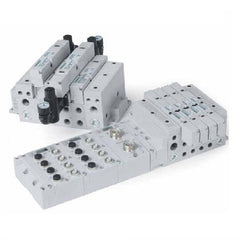Product Detail
12 Series
Quick Overview
MINIATURE FRL SERIES
Particulate & Coalescing Filter, Regulator, Filter/Regulator, Lubricator, Shut-Off Valve, Diverter Block
Port Size: 1/8 & 1/4 NPT, G, R ThreadsNumatics' 12 Series is a miniature FRL series. The compact design with high flow characteristics is easy to assemble, offering low cost, light weight, and low profile option to customers. Other features of the 12 Series include:
- OEM modification available
- Can be installed as modular or individual
- Variety of bowls & drains
- Shut-off valves and diverter blocks available
- Black anodized aluminum heads
- 1/8 or 1/4 NPT, G, or R threads
Particulate Filter
Primary air filters are designed to separate liquid, water, rust, pipe scale, and debris from air lines. They should be installed upstream of the regulator and/or lubricator to prevent contamination from reaching other components.
Water is removed mechanically by the deflector which causes the air to move in a swirling motion. The condensed water droplets are then centrifugally impounded upon the ID of the bowl then fall down past the quiet zone baffle to the water sump. Dry air passes through the sintered element utilizing depth filtration and removes debris down to specified micron size.
Coalescing Filter
The coalescing filter is utilized when either clean air is required or longer component life is desired. This type of filter removes water and oil aerosols. It works differently than the particulate filter; dirty air enters the element from the center and passes through a field of glass fibers which cause the aerosols to form into droplets which are heavier than the surrounding air. The droplets grow larger as they pass through the element and gravity causes the oil drops to drain to the sump of the bowl. To maximize the life of a coalescing filter it should always be used after a 5 micron particulate filter or with the optional pre-filter.
Regulator
Regulators are used to reduce pressure to a required working pressure. They consist of a diaphragm which floats between a main spring (top) and a valve (bottom). By turning the adjustment handle clockwise, the main spring is forced onto the rubber diaphragm which, in turn, is pressed onto the valve stem. When the spring pressure becomes greater than the air pressure in the control chamber below the diaphragm, the valve is forced down and flow begins. As flow continues, the pressure begins to build and air, via the aspirator tube, fills the control chamber and forces the diaphragm upward. As forces balance, the small spring under the valve piston causes the valve to close. The cycle continues in a balanced process of reducing or increasing flow based upon the downstream pressure.
Particulate Filter/Regulator
The integral part of the filter/regulator (‘piggyback’) is a two station component designed to filter and regulate compressed air when cost and space are of primary concern. As wet, dirty air enters, it immediately flows through the air deflector, causing the air to move in a swirling motion. After condensed water is centrifugally removed, air passes through the filter and into the regulator. The high pressure of the air is systematically reduced via the adjustment spring and valve and exits the housing as clean and dry air that is ready to work at the specified pressure.
Coalescing Filter/Regulator
The Coalescing Filter-Regulator is designed to provide superior filtration and regulation in one compact housing. It combines a multiple support cartridge style borosilicate glass element with a pilot balanced regulator to assure the maximum performance of downstream components. Available with four different element grade choices, the C Series Coalescing Filter-Regulator can be outfitted to attack and remove the exact type of contamination that is critical to a specific application.
Lubricator
Usually mounted third in the FRL Series, the lubricator is designed to inject oil aerosols into the airstream of a pneumatic circuit. As air flows from the regulator, some air is diverted from the main orifice to pressurize the bowl. This forces oil up the siphon tube past a flow check and into the integral valve/sight dome. The oil film then drops through the valve and into the atomization chamber at a rate that is automatically proportional to the air flow. This virtually eliminates the need for readjustment.
Shut-Off Valve
The 12 Series Shut-Off Valve is an easy and inexpensive way to add shut off capability to an FRL. The valve includes a lockout feature designed for a padlock to prevent unauthorized downstream pressurization during maintenance. The shut off valve is usually mounted first in the assembly.
Diverter Block
Designed to give FRLs total versatility, the diverter block mounts directly inline with the FRL combination. Additional components can then be manifold mounted in a compact manner that doesn’t cause excessive pressure drop. There are two available ports per unit; both are tapped for standard service.





